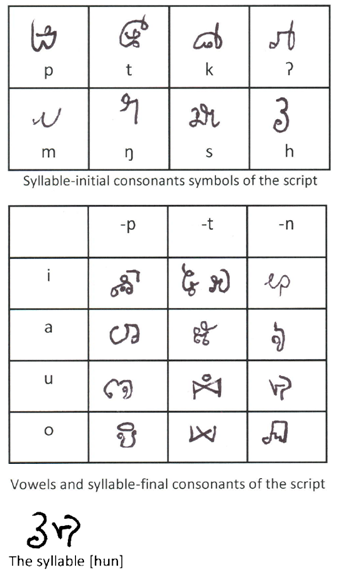Khom Script (Ong Kommadam) on:
[Wikipedia]
[Google]
[Amazon]
 The Khom script is a writing system used in
The Khom script is a writing system used in
A Description of Jruq (Loven): a Mon-Khmer language of the Lao PDR.
Unpublished MA thesis, Australian National University. (Script described in appendix II, pp. 521–525) * Sidwell, Paul. 2008. The Khom script of the Kommodam Rebellion. ''
 The Khom script is a writing system used in
The Khom script is a writing system used in Laos
Laos (, ''Lāo'' )), officially the Lao People's Democratic Republic ( Lao: ສາທາລະນະລັດ ປະຊາທິປະໄຕ ປະຊາຊົນລາວ, French: République démocratique populaire lao), is a socialist ...
. The term "Khom" is also used to refer to the Ancient Khmer lettering used in Thailand's Buddhist temples to inscribe sacred Buddhist mantras and prayers, but that is an entirely different script.
History
The script was invented by Ong Kommadam, a leader in the rebellion against the French colonizers. He began using the script as early as 1924, but its use did not continue after his death in 1936. Ong Kommadam claimed supernatural titles, including “King of the Khom”, “God of the Khom”, “Sky God of the Khom” (Sidwell 2008:17). The script was linked to his divine claims, messages written in this script carried mystical power as well as meaning. The script was invented for conveying secret messages that could not be deciphered by the French or Siamese forces that had divided Laos byOng Kommandam Ong Kommandam (also Ong Kommadam) was the confidant and successor of Ong Keo as the leader of the Mon-Khmer tribes of southern Laos in their struggle for independence from French and Lao rule. Ong Keo was assassinated in 1910 by the Commissioner o ...
, who had taken over as leader after the death of Ong Kèo during the Holy Man's Rebellion. As Ong Kommandam and many of his closest followers were speakers of Bahnaric languages
The Bahnaric languages are a group of about thirty Austroasiatic languages spoken by about 700,000 people in Vietnam, Cambodia, and Laos. Paul Sidwell notes that Austroasiatic/Mon–Khmer languages are lexically more similar to Bahnaric and Katui ...
spoken in southern Laos, most of the known texts in the language were written in Alak—Ong Kommandam's native language—and the Bahnaric Loven languages of Juk, Su' and Jru', and some in Lao.Jacq, Pascale. 2001. Description of Jruq (Loven): a Mon-Khmer language of the Lao PDR. Unpublished MA thesis, Australian National University. (Script described in appendix II, pp. 521–525)
The script was revealed to outsiders by old, dying insiders on two occasions (Sidwell 2008). Although the word ''Khom'' originally referred to the Khmer, it was later applied to related Austroasiatic peoples such as the Lao Theung
The Lao Theung or Lao Thoeng (Lao: ລາວເທິງ ) is one of the traditional divisions of ethnic groups living in Laos (the others being the Lao Loum and the Lao Soung). It literally indicates the "midland Lao", and comprises a variety o ...
, many of which had supported Ong Kammandam.
Characteristics
This ''Khom'' script is unusual in the way it divides syllables. It has one set of symbols to represent initial consonants. Then it uses another set of symbols to represent the final vowel and consonant. That is, unlike asyllabary
In the linguistic study of written languages, a syllabary is a set of written symbols that represent the syllables or (more frequently) moras which make up words.
A symbol in a syllabary, called a syllabogram, typically represents an (optiona ...
(which has unitary symbols for consonants followed by vowels (CV), with maybe a vowelless consonant following), Khom script divides the syllable as C-VC, rather than CV-C (Sidwell 2008). This onset-rime division is not readily accommodated in any of the existing typologies of scripts, though shared by Zhuyin Fuhao
Bopomofo (), or Mandarin Phonetic Symbols, also named Zhuyin (), is a Chinese transliteration system for Mandarin Chinese and other related languages and dialects. More commonly used in Taiwanese Mandarin, it may also be used to transcribe ...
.
Some of the symbols resemble those from nearby scripts, but many are original. The script contains more than 300 characters, in order to fully encompass the rich morphology of the Bahnaric languages
The Bahnaric languages are a group of about thirty Austroasiatic languages spoken by about 700,000 people in Vietnam, Cambodia, and Laos. Paul Sidwell notes that Austroasiatic/Mon–Khmer languages are lexically more similar to Bahnaric and Katui ...
.
Although the shapes of the letters have a superficial resemblance to several writing systems in the area, it was not related to any of them.
The script could be used to write various Bahnaric languages
The Bahnaric languages are a group of about thirty Austroasiatic languages spoken by about 700,000 people in Vietnam, Cambodia, and Laos. Paul Sidwell notes that Austroasiatic/Mon–Khmer languages are lexically more similar to Bahnaric and Katui ...
, including the Laven dialects, especially Jru', and languages like Alak, Ong Kommadam's native language.
Notes
References
*Jacq, Pascale. 2001A Description of Jruq (Loven): a Mon-Khmer language of the Lao PDR.
Unpublished MA thesis, Australian National University. (Script described in appendix II, pp. 521–525) * Sidwell, Paul. 2008. The Khom script of the Kommodam Rebellion. ''
International Journal of the Sociology of Language
The ''International Journal of the Sociology of Language'' is a peer review, peer-reviewed academic journal covering the field of sociology of language. It was established in 1974 by the eminent sociologist of language Joshua Fishman, who has serve ...
'' 192.
Writing systems
Constructed scripts
{{writingsystem-stub